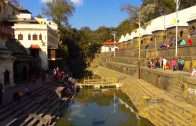Cremation Temple Pashupatinath
The Pashupatinath Temple is a famous, sacred Hindu temple dedicated to Pashupatinath on the banks of the Bagmati River 5 kilometres north-east of Kathmandu Valley in the eastern part of Kathmandu, the capital of Nepal.
This temple is considered one of the sacred temples of Hindu faith and serves as the seat of the national deity, Lord Pashupatinath. This temple complex is on the UNESCO World Heritage list Since 1979. This “extensive Hindu temple precinct” is a “sprawling collection of temples, ashrams, images and inscriptions raised over the centuries along the banks of the sacred Bagmati river”.
People arrive here to find shelter for the last several weeks of their lives, to meet death, be cremated on the banks of the river and travel their last journey with the waters of the sacred river Bagmati, which later meets the holy river the Ganges. Hinduists from every corner of Nepal and India are arriving here to die.
It is believed that those who die in Pashupatinath Temple are reborn as a human, regardless of any misconduct that could worsen their karma. The exact day of their death is predicted by astrologers of the temple. It is a temple with a special atmosphere of death; death is present in almost every ritual and every corner of it.
The main temple of Pashupatinath is a building with a bunk roof and a golden spire. It is located on the Western bank of Bagmati and is considered a masterpiece of Hindu architecture. It is a cubic construction with four main doors, all covered with silver sheets.
The two-storied roof is made from copper and is covered with gold. This richly decorated temple with wooden sculptures is believed to make wishes come true. One of the most astonishing decorations of the temple is the huge golden statue of Nandi – Shiva’s bull.
Only followers of Hinduism can enter the main temple, but all the other buildings are available for foreigners to visit. From the Eastern bank of the river, the main temple can be seen in its whole beauty. The western bank of Bagmati also hosts the so-called Panch Deval (Five temples) complex, which once was a holy shrine but now serves a shelter for destitute old people.
Numerous religious buildings are also located on the eastern bank of Bagmati, most of them are devoted to Shiva. The majority of these buildings are small single-storey constructions made from stone. From the outside, these buildings are reminding crypts, but in reality, these are sacral buildings, created for holding the symbol of the deity Shiva – lingam (erect phallus). Lingams can be found all over the complex.
Along the right bank of Bagmati, numerous platforms for funeral pyres are built. The cremations on these platforms are a common activity.
It is also very common to meet sadhus in Pashupatinath. Sadhus are wandering ascetic yogis, who are trying to acquire liberation from the cycle of death and rebirth by meditating. They have a very unique appearance with specific yellow paintings on their bodies.
The area of Pashupatinath encompasses 264 hectares of land including 518 temples and monuments. Main pagoda style temple is located in the fortified courtyard within the complex guarded by Semi-Military Nepal Police and Military Force Nepal Army and has a police outpost along with living quarter within. In front of the western door, there is a huge statue Nandi bull, in bronze. Along with many temples and shrines of both Vaishnav and Saiva tradition.
The temple was erected anew in the 15th century by Lichhavi King Shupuspa after the previous building was consumed by termites. Over time, countless further temples have been erected around this two-storied temple. These include the Vaishnava temple complex with a Ram temple from the 14th century and the Guhyeshwari Temple mentioned in an 11th-century manuscript.
Temple courtyard has 4 entrances in all directions. Temple security (Armed Police Force Nepal) and Pashupatinath area development trust are selective regarding who is allowed entry into the inner courtyard. Practising Hindus and Buddhist of Nepali are only allowed into Temple courtyard. Practising Hindus of western descent are not allowed into the temple complex along with other non-Hindu Visitors with an exception to Sikh and Jain groups if they are of Indian ancestry.
Pashupatinath Temple is the oldest Hindu temple in Kathmandu. It is not known for certain when built. But according to Nepal Mahatmaya and Himvatkhanda, the deity here gained great fame there as Pashupati, the Lord of all Pashus, which are living as well as non-living beings. Pashupatinath Temple’s existence dates back to 400 B.C. The richly ornamented pagoda houses the sacred linga or holy symbol of Lord Shiva. There are many legends describing as to how the temple of Lord Pashupatinath came to existence here. Some of them are narrated below:
The Cow Legend
Legend says that Lord Shiva once took the form of an antelope and sported unknown in the forest on Bagmati river’s east bank. The gods later caught up with him and grabbing him by the horn, forced him to resume his divine form. The broken horn was worshipped as a linga but over time it was buried and lost. Centuries later astonished herdsmen found one of his cows showering the earth with milk. Digging deep at the site, he discovered the divine linga of Pashupatinath.
The Lichchhavi Legend
According to Gopalraj Vamsavali, the oldest ever chronicle in Nepal, this temple was built by Supuspa Deva, a Lichchhavi King, who according to the stone inscription erected by Jayadeva 11 in the courtyard of Pashupatinath in 753 AD, happened to be the ruler 39 generations before Manadeva (464-505 AD).
The Devalaya Legend
Another chronicle states that Pashupatinath Temple was in the form of Linga shaped Devalaya before Supuspa Deva constructed a five-storey temple of Pashupatinath in this place. As time passed, the need for repairing and renovating this temple arose. It is learnt that this temple was reconstructed by a medieval King named Shivadeva (1099-1126 AD). It was renovated by Ananta Malla adding a roof to it. Thousands of pilgrims from all over the world come to pay homage to this temple, that is also known as ‘The Temple of Living Beings‘.
Other beliefs
There are several complex stories involving the origins of Pashupatinath. One story goes, in brief, that Shiva and Parvati came to the Kathmandu Valley and rested by the Bagmati while on a journey. Shiva was so impressed by its beauty and the surrounding forest that he and Parvati changed themselves into deer and walked into the forest. Many spots in the Kathmandu Valley have been identified as places where Shiva went during his time as a deer. After a while, the people and gods began to search for Shiva. Finally, after various complications, they found him in the forest, but he refused to leave. More complications ensued, but ultimately Lord Shiva announced that, since he had lived by the Bagmati river in a deer’s form, he would now be known as Pashupatinath, Lord of all animals. It is said that whoever came here and beheld the lingam that appeared there would not be reborn as an animal.
Finding of Shiva Linga at Pashupatinath Temple
It is said that the wish-fulfilling cow Kamadhenu took shelter in a cave on the Chandravan mountain. Everyday Kamadhenu went down to the place the lingam was sunken into the soil and poured her milk on top of the soil. After a few thousand years some people saw Kamadhenu pouring milk on that same spot every day, and started to wonder what that would be. So they removed the soil and found the beautiful shining lingam and started worshipping it.






